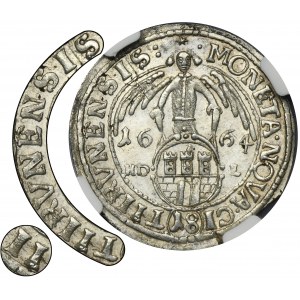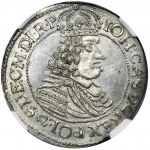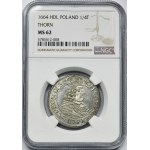A rare variant of the Thorvnensis orta with the incorrect inscription TIIRVNENSIS instead of THORVNENSIS, with two letters II instead of the letter H, and with the letter R punctuated. The variety with the letter H in the inscription THRVNENSIS in the Dutkowski-Suchanek catalog "Corpvs Nvmmorvm Civitatis Thorvnensis" is specified with a rarity grade of R4, which is already a rare item, and in the case of the presented piece we have a significant increase in rarity thanks to II instead of H. On the reverse, on the sides of the city coat of arms, the initials HDL of Hans Dawid Lauer, mincmaster of the Torun mint.
As a curiosity, it should be added that the authors of the catalog in Corpvs Nvmmorvm Civitatis Thorvnensis did not pay attention to this error, qualifying the coin as a variety with the inscription THRVNENSIS. The error was probably caused by a clogged stamp after a certain piece was struck, as a result of which the last pieces struck do not have a bar in the letter H and it looks like two letters II.
A rarity in beautiful state of preservation, appreciated with the second highest grade in the NGC registry.
Nevertheless, in our opinion, the technical grade from NGC does not reflect the beauty of the coin on offer. The detail for this issue is exquisitely rendered, the background exceptionally fresh, with a strong luster.
A superb coin that pleases with its impeccable presentation.
One of the rarest Torun orts in preservation condition, which can confidently be classified as a specimen.
At the beginning of the reign of Jan Kazimierz there was an ambitious attempt at monetary reform (1650). A ban on the circulation of foreign money was introduced and the issuance of good money of its own began. It was then that copper shekels (wide) first appeared. The assumptions of the reform proved unrealistic so it was quickly withdrawn. Meanwhile, in Lithuania, which did not feel obliged to implement the 1650 reform (its representatives did not participate in the work of the commission), a parallel reform was introduced, based on other principles. In view of the Moscow invasion, the Vilnius mint worked only in 1652-1653. In turn, under the conditions of the Swedish Deluge, an important episode in the history of Polish minting was the launch of a makeshift crown mint in Lviv (1656-1657). The monetary relations of the Commonwealth tried to put in order the ordinance of 1658. The most notable for the period of the reign of Jan Kazimierz were the issues of subvalue money: small copper crown and Lithuanian shekels (so-called boratins) minted in the number of about 2 billion pieces, and zlotys (so-called tymfs), with an official value of 30 pennies - more than twice the actual silver content of the coin. Of the municipal mints in the period in question, there were mints in Gdansk, Elblag and Torun. John Casimir also exercised his minting rights as Prince of Opole and Racibórz (three-crore orts were minted at the Opole mint).
During the time of Jan Kazimierz, orts were minted at nine mints: five crown mints (Bydgoszcz, Wschowa, Poznan, Krakow, Lviv), a Lithuanian mint (Vilnius) and three city mints (Gdansk, Torun, Elblag). The most abundant minting production was developed in Cracow and Bydgoszcz. In terms of iconography, on the other hand, the mints in Wschowa and Lviv stood out. The former, due to the depiction of the king in ancient armor and with a laurel wreath on his head (instead of a crown), the latter due to the primitivism of the drawing associated more with folk art than with the activities of the state mint. Lithuanian orts were minted only in 1664. Of the city orts, the rarest and - consequently - the most desirable to collectors are the Elblag orts. The first issues of John Casimir's orts were based on the 1650 orts. The coins were minted from 14th-karat silver, weighed an average of 5.607 g and contained 4.906 g of pure bullion. In 1654, the standard of the orta was lowered slightly. At that time, the sample of silver was set at XI lute, the weight of a single piece was set at 6.726, and the content of pure silver was to be 4.626 g. In 1656, there was another change - respectively, the sample of silver was set at XI of lats, the weight was set at 6.308 grams, and the pure silver content was set at 4.337 grams. This was not the last change in the standard of the orta. As of 1657, the following values were in effect: sample of XII lavs, weight - 5.312 g, pure silver - 3.984 g. The last change was brought by the Ordinance of 1658 (the most durable of Jan Kazimierz's legal acts relating to minting). It adopted for the orts a silver sample of X lows, an average coin weight of 6.308 g and pure silver content of 3.943 g.












